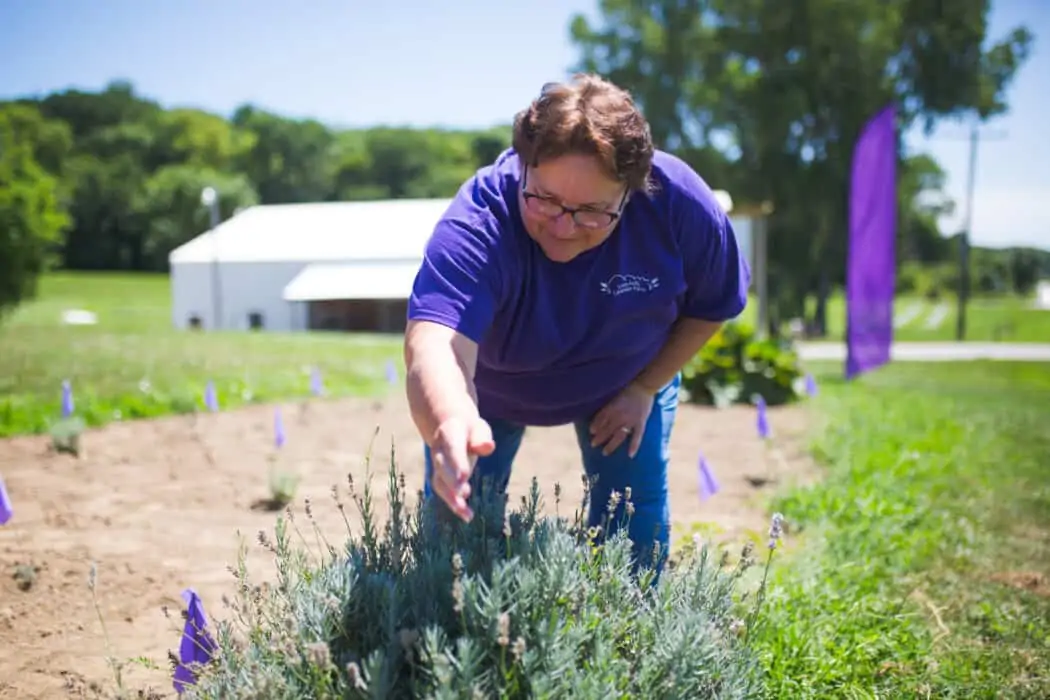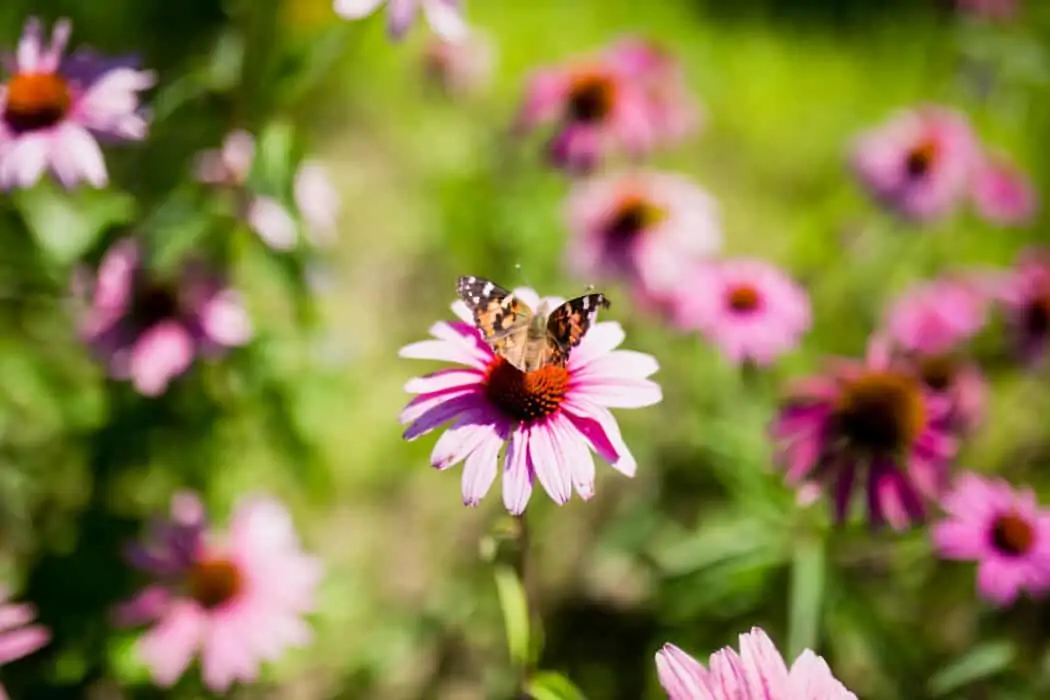I have spent over the past 8 years traveling the country for FarmHer. I’ve been to all kinds of farms, big and small, from coast to coast. On many of those farms, whether it was blueberries in Florida, almonds in California, or any other types of nuts, berries, and fruit I learned the importance of pollinators.

All of those farms rely on pollinators – bees, bugs, butterflies, and more – to pollinate the flowering plants that bear the fruit. It isn’t just nice to have, it is an essential piece for these types of plants to have a crop. Some of the larger farms that I visited in California bring in commercial bee colonies to pollinate their plants while other, smaller operations rely on the natural flow of pollinators. The necessity and important role that pollinators play in the food we all eat every day became very clear from farm to farm.
Pollinator Projects From the Past
Adding to my pollinator awareness, a few years back I did a few FarmHer Talks podcasts about pollinators. One was with Kerry Carstens of Corteva about pollinators. I learned SO MUCH about the current state of pollinators and what we all can do to help.
Another was with a program through a local zoo called Plant, Grow, Fly. It really opened my eyes to the ability we all have to help provide pollinator habitat in large and small ways.
Obviously, farms have larger pieces of ground that could serve as habitat, but those of us urban dwellers could plant certain types of bushes or flowers in smaller spaces, like pots on a deck, that also promote pollinators and provide essential food for the hardworking insects that are a major part of feeding the world.

In the summer of 2020, I visited the Loess Hills Lavender farm (yes, a lavender farm in Western Iowa) that had acres and acres of the most beautiful pollinator habitat I have ever seen. It was literally buzzing with bees, butterflies, and all sorts of other pollinators feasting on the brightly colored flowers covering the gently rolling hills.

Pollinator Project at My Own Farm
I decided then and there that I needed to do something at home to encourage pollinators. What I didn’t realize was that when I arrived home from that trip our years-long search for our own little “farm” would finally come to an end.
Tony and I both grew up in the country and have long wanted to move back outside of town to give that same experience to our kids. That search proved to be more difficult than we expected because we wanted to stay in the same school district. We also needed unlimited high-speed internet to be able to work at our home.
Over the years every time we found a potential place it was either too expensive, not the house we needed or, it didn’t have the opportunity for high-speed internet. Finally, we found the right spot.
The Perfect Spot
It was close enough to town to get high-speed internet, had five acres to do as we wanted, and was in the same school district. When we went to look at the house the three-ish acres of fallow ground on the north side of the property was what caught our eye. The sellers had gotten tired of mowing the entire thing a number of years ago and decided to let it go, leaving paths mowed around and through the land for walking. When Tony and I walked the paths and looked at the land filled with a variety of natural growth such as mulberries, red cedar, other trees, and plenty of tall grass. There were birds, bees, and butterflies everywhere. I instantly had the vision of making this into pollinator habitat, filled with those beautiful flowers and plants that I had seen at Loess Hills.

A few hundred signatures later, the acreage was ours and the real work began.
Over the coming months, we worked with our friends at Remodelworks to knock out walls, replace flooring, doors, trim, paint, cupboards, counters, redo bathrooms and so much more. As the work was going on inside, I dreamt about what was to come outside.
Corteva + FarmHer = The Pollinator Pair
Over the years FarmHer has partnered with Corteva on a variety of projects. And I was well aware of their Pollinator program so as I dreamed, I reached out to them about my vision for pollinator habitat. Of course, they jumped into action, hooking me up with agronomists, habitat specialists, Pheasants Forever, and other resources that I would need to figure out how to start my pollinator project.

Now is a good time to remind you that I had big dreams of taking those 3 acres and converting the entire area to a field full of flowers. In my head, we would sprinkle seeds around and boom, it would happen. You can take a minute to laugh a bit here…as you might guess the process wasn’t as easy as that.
In visiting with the specialists at Corteva I quickly learned that the ideal way to prepare for and install a habitat included clearing the land, eliminating the grass and weeds that are there that could be a threat to my future flowers. Then, after the land is cleared I could plant the seed, but that seed would take more than one season to begin to grow into the beautiful space I had in my mind. We could plant some plugs of plants to expedite that BUT that would be a lot more expensive. The size and scale of the project I had imagined started to hit me. I realized I needed to sit down and talk with Tony about it because it would majorly change our acreage and I would need help to get it all done.
The Plan
We walked around the property and talked it out and I came to the conclusion that I needed to scale back my project a bit. Ok, not just a bit, but a whole lot.
We decided to start with a small area about 10×10 feet near the road and alongside the driveway instead of my original 3-acre idea because I realized it is better to start with something do-able rather than overwhelm all of us from the start. My plan is that we will use this space to learn on and grow from there!

In working with Corteva and Pheasants Forever we created a plan that starts with us mowing down the grass and killing the grass and weeds in that space late this summer. Then, we will wait about a month, repeat the process, and by October will have bare ground where we will plant a mix of seeds and plugs. Then, we wait.
Pollinator Dreams Coming True
Stay tuned as I share the ups, downs, ins, and outs of starting our own pollinator habitat. In the meantime, for some instant gratification, I received a few packs of native pollinator plants from Pheasants Forever this summer. I planted them in two bare spots we already had out by the road.
In true rural life fashion, something (a raccoon I think) immediately dug them back up but a few of them made it. It’s not a field of flowers, but it is a start…and getting started is what matters the most!




Good morning. Marji oh my lord this is a dream of mine too. I love the bees (and other creatures) that pollinate my plants. Are you going to be selling a Pollinator Kit? JLMK!
J. Connor
Proud of you Marji! I can’t wait to come visit.
Dear Marji
Thank you so much for the information you posted regarding the pollinators on your property
which is absolutely beautiful. Your efforts are there to see. We have many butterflies and
dragonflies, bees etc. during the summer months. They truly do make a difference especially
with the Jacobs coat roses. Field of flowers is a wish of mine as well. Will give it a try this
summer. Just adore your program on Friday night at 7:00 PM California time. Your program
has given so much joy to so many women throughout the country especially the information
concerning the way of life women have on their own farms, ranches. Life for women can
abound and they can profit with this way of life. We are Architects urban and city planners
and we fight with developer’s all the time to hold on to the way of life you depict on television.
Hopefully in the future you will be able to host another Farm Her convention in Iowa.
Iowa is favorite farm state of mine and I look forward to seeing different aspects of life there
when you program it. Sending you the very best regards and respect from one farm her to
another.
Sondra Sheftz
21742 Don Gee Court
Santa Clarita, California 91350
661-367-4916 home phone
A final note…it appears to be true that red flowers attract bees. This morning I have 12 to 15 bees on my penta bush. So let the Red flowers flow in your pollinator habitat.
Very, VERY COOL!! I have enjoyed your FarmHer shows on RFDTV. I too am wanting to plant pollinator plants, but I’m wanting to do so mostly for the bees as I now have 2 Hives. The task is daunting as there is sooo many plants. I need to make sure that there are plants emerging at different times for different pollination times. Any help would be appreciated. I have roughly about 3 acres that is tillable. Thanks. Chad.